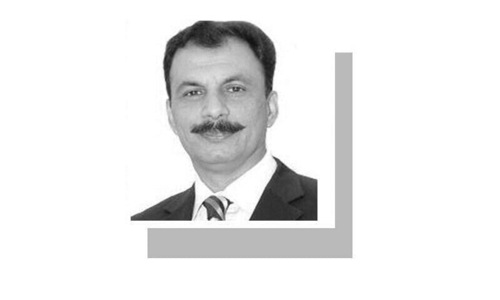 Amid deteriorating economic indicators and continuing political turmoil, independent economists believe that the government - irrespective of who is running the show – is running short of time for taking long pending, tough policy decisions for resource mobilisation.
Amid deteriorating economic indicators and continuing political turmoil, independent economists believe that the government - irrespective of who is running the show – is running short of time for taking long pending, tough policy decisions for resource mobilisation.
With mounting risks to macro-economic stability and no remedies yet in sight, financial analysts ask: Is the government taking a path that would put Pakistan again in the lap of International Monetary Fund within a couple of years of breaking the proverbial begging bowl or the national economic sovereignty could be salvaged by bold decisions upfront?
Those within and outside the government concur that the country has moved into the vicious cycle. The prices are out of hand, while fiscal deficit and energy crisis are emerging as a major risk to the current growth momentum.
In the first quarter of the current fiscal year, the fiscal deficit increased to 1.6 per cent of GDP against the targeted one per cent. If the trend continues, this year’s deficit should not be less than 6.4 per cent, much higher than the target. In the first six months, the Federal Board of Revenue is set to reduce revenue target by Rs35 billion. Coupled with this, another additional burden of Rs100 billion in subsidies on oil and electricity would further raise the overall fiscal deficit.
And the current account deficit is rising every year; foreign capital and financial inflows are adding to outflows; and repayments due this year of the $12.5 billion foreign debt that was re-profiled five years ago, will increase.
“The next six months would be crucial for the macroeconomic management of the economy particularly the policy of subsidising oil, power and food items”, the central bank chief Dr Shamshad Akhtar warned the federal government on Tuesday last.
Is Musharraf administration strong enough to confront the critical fiscal challenges head on? Is it time to tax real estate and stock market for additional resource mobilisation given the fact that deals worth billions of rupees take place in each sector every day while contributing very little to the real economy? Or the axe has again to fall on general public when the vast majority of the population is already struggling for survival. About 74 per cent – still lives on less than Rs120 per day. Economists understand that policy options are limited and the time, if available at all, is short to remove worsening fiscal imbalances.
Prominent economist Dr A. R Kemal says “the situation on fiscal deficit is very dangerous”. He explains that current fiscal deficit (expected 6.4 per cent of GDP) is worked out on the revised base of 1999-2000. If calculated on the old base, this deficit would be in excess of eight per cent of GDP. There are only two options to contain this deficit: resource mobilisation and cut in expenditure. Otherwise, the fiscal deficit is going to go up. Easier solution for the government is to cut expenditure because it has not mobilised additional resources. Again, the expected cut on expenditure will be in the form of reduction in public sector development programme that would further hamper the economic growth.
The only option is to introduce new direct taxes, said an economist working with the government. The avenues left are capital gains tax – an area exempted till June 2008 – and wealth tax on real estate. And no serious efforts have been made to realise the potential revenue from income-tax on agriculture as this sector is dominated by the influential feudal and military class. These special interests have also so far effectively prevented the development of a proper tax base on real market value rather than fictitious price reported in the sale deeds, says Dr Kemal.
In the absence of these options, the resources to meet fiscal deficit can come either through foreign debt, through loans from the general public or banking borrowing. While the foreign aid or loans would mostly be dependant on geo-political situation with a cost to sovereignty, there will be a need to increase interest rates on national savings or Pakistan Investment Bonds that would multiply the domestic debt servicing cost and put pressure on the banking industry. The third source, loan from domestic banks, is more tricky and costly since the banks would have to bid for the money, the government would require and cost may go beyond 15 per cent. In the short run, however, the government can borrow from the central bank that would result in increased money supply and higher inflation.
The problem is that the only way to contain money supply is to reduce credit to the private sector. If that is done, the investment is going to be hurt and interest rates would rise further. So the only way of controlling money supply is to contain fiscal deficit, which in fact is the real problem and presents a chicken and egg situation. These were the signs that led us to the IMF in the 1990s when the balance of payment and the fiscal deficit were unsustainable. “So there can again be the same situation by end of this fiscal year”, says Dr Kemal. The only saving grace is around $15.5 billion reserve which can evaporate anytime, and we would be forced to go back to the IMF, he says.
Caretaker minister for finance Dr Salman Shah, however, says the situation today is much different than the 1990s and there is no need to go back to the IMF. He concedes that there are many risks to the economy this year but the country now had huge foreign exchange reserves, a much bigger economy and a lot of inflows and resources to sustain so many shocks. He said the Central Bank projected the economic growth rate at 6.6 per cent but any rate between 6.5 to 8.5 per cent was a good number to have.
“I am very optimistic that there will be no difficulty” because the objective was to achieve the target of four per cent fiscal deficit and there should be no big deal if it is done through fiscal adjustments that may slash development budget as well. He said the government still had six months to make budget adjustments to overcome the real issue of increasing subsidies. The exchange rate was getting more competitive and competitiveness of exports was not an issue despite domestic violence. He was non-committal on taxing the capital market, the land market and the agriculture but agreed that every sector has to come under the tax net with the passage of time.












































Dear visitor, the comments section is undergoing an overhaul and will return soon.